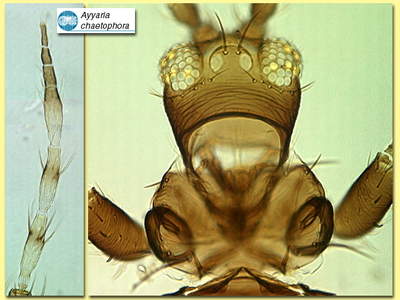Figures
Fig. 1 Antenna, head and prothorax
Fig. 2 Head, thorax, abdomen and pronotum
Fig. 3 Fore and hind wing
Species
Ayyaria chaetophora KarnyBiology
This is a common tropical leaf-feeding species that is probably polyphagous. It is particularly associated with legume crops including soybeans and Dolichos lablab, also Calopogonium, but substantial numbers have been found on the leaves of other plants including garden Tagetes.
Distribution
India and S.E.Asia to northern Australia, Japan, Taiwan and Tahiti.
Recognition
Body brown, abdomen particularly dark, tarsi and mid and hind tibiae clear yellow; antennal segments III-VIII yellow with light brown shadings; forewings bicoloured, clear with brown transverse bands in second and fourth fifths. Head with weak transverse sculpture near posterior; one pair of ocellar setae long and arising within ocellar triangle. Antennae slender, 8-segmented, segments III & IV with sense cone small and forked; VII+VIII shorter than VI. Pronotum with little sculpture, 2 pairs of long posteroangular setae and 1 or 2 long pairs on anterior margin. Metanotum with no sculpture medially; median setae not arising at anterior margin. Tarsi 2-segmented. Forewing first vein with 3 widely spaced setae on distal half of wing; second vein with about 3 widely spaced setae. Abdominal tergites with regular equiangular reticulation anterior to median pores; VIII with posteromarginal comb of long microtrichia; X with no longitudinal division dorsally. Sternites with 3 pairs of marginal setae but no discal setae. Male similar to female but abdomen slender; tergite IX medially with a pair of stout setae arising from prominent tubercles, posterior to these a group of about 5 small tubercles; sternites with no glandular areas.
Related species
There is only one species in this genus. It resembles panchaetothripines in the reticulate sculpture of the abdominal tergites, but has long setae on the head, pronotum and forewings.




